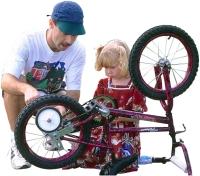 February 22nd, 2012 by Robert Franklin, Esq.
February 22nd, 2012 by Robert Franklin, Esq.
Contrary to perceptions propagated by anti-father groups and certain members of the news media, equal parenting between high-conflict parents tends to produce better child outcomes than sole custody and even reduces the amount of conflict over time. That’s one of Dr. Edward Kruk’s key arguments for Equal Parental Responsibility in custody cases in his article “Arguments for an Equal Parental Responsibility Presumption in Contested Child Custody,” that appeared in the January edition of The American Journal of Family Therapy.
Opponents of the 2006 amendments to the Family Law Act in Australia made the point repeatedly that a presumption of shared parenting couldn’t work in high-conflict divorces. In England, the family justice review headed by David Norgrove relied on those same arguments in recommending that no change be made to fathers’ rights to children or children’s rights to their fathers. As Kruk makes clear, the claim is without merit.
One of the problems with the research on parenting arrangements in high-conflict divorces is that much of it fails to differentiate between parental contact and parenting time. To be clear, parental contact refers to how much time the parents spend in each other’s company and interacting with each other. The more of that there is when there’s a lot of animosity between the parents, the greater the level of conflict.
By contrast, parenting time is how much time parents spend with their children.
Now, it should be obvious that greater parenting time doesn’t necessarily involve greater interaction between the parents. For example, if Dad gets the kids every weekend, that means he and Mom meet each other twice – Friday and Sunday evenings in a seven-day period. But if Dad has the kids for a week and Mom has them for a week, the two adults again see each other twice, but Dad’s had more time with the kids.
As an aside, I’ve often wondered why the default position in custody matters regarding kids over the age of about four isn’t two weeks with Dad followed by two weeks with Mom. That’s equal parenting, and less upsetting to the children’s schedules than the usual every-other-weekend routine imposed by judges. The kids would pack up and move less often in a given period of time, while the parents would get equal custody. So what’s the problem with that? I’ve never figured it out.
In any case, where both parents are fit to care for children,
More recent studies… have found not only that EPR (Equal Parental Responsibility) is not harmful in high-conflict situations, but equal parenting can ameliorate the harmful effects of high-conflict: a warm relationship with both parents is a protective factor for children in high conflict families.
Various researchers have found that the negative outcomes for children associated with high-conflict parents are “mediated by paternal involvement.”
Finally, Fabricius, Diaz and Braver (2011) determined that children’s ongoing relationships with each parent can counter the harmful effects of parental conflict, and that limiting parental time when there is parental conflict makes children doubly vulnerable to long-term physical and mental health problems.
More to the point, the current system of “winner-take-all” custody itself promotes conflict between parents. To anyone who’s been involved in a custody case, this is all but self-evident. Parents know to a virtual certainty that one of them is going to be “awarded” the children almost to the exclusion of the other parent. They also know that, in order to receive that “award,” it will be advisable to depict the other parent in the worst possible light.
Lawyers often fail to reduce conflict between parents. Indeed, they do the opposite for the clear reason that, in custody cases, the greater the acrimony, the more motions need to be filed, the more court appearances made, the more depositions taken, etc., all of which result in ever greater fees to the lawyer. Given that, is it any surprise that state family bar associations invariably oppose equal parenting?
So the evil genius of our system of custody rulings is to do everything in its power to exacerbate conflict and then decide that, since there’s conflict between the parents, only one – Mom – can have custody. It’s wrong in every possible way.
Unsurprisingly, social science finds to be true what divorcing parents have known for years.
“Winner-take-all” adversarial processes and sole custody or primary residence orders are strongly associated with exacerbation or creation of parental conflict.
Non-custodial fathers are more likely to resent their custodial exes than are Dads with equal custody.
Inter-parental conflict decreases over time in shared custody arrangements and increases in sole-custody arrangements; interparental cooperation increases over time in shared custody arrangements and decreases in sole custody arrangements. (Citations)… The culture of animosity created by the sole-custody system seems tailor-made to produce the worst possible outcomes when there are two capable parents who wish to continue as primary caregivers, cannot agree on a parenting plan, and are forced to disparage each other within the adversarial system in an effort to simply maintain their role as parents.
Most perversely, the current system of custody decisions by family judges often rewards with custody the more adversarial parent. In short, it tends to place children in the sole care of the parent who has “won the war” by being more conflictual than the other.
Finally,
Most acrimonious parents can successfully learn to minimize conflict when motivated to do so, and an EPR presumption provides an incentive for parental cooperation, negotiation, mediation and the development of parenting plans.
In short, the argument that equal parenting can’t work in high-conflict divorces is flat wrong. It not only can work, it works better than what family courts now prefer – the removal of one parent from the child’s life, almost entirely.
